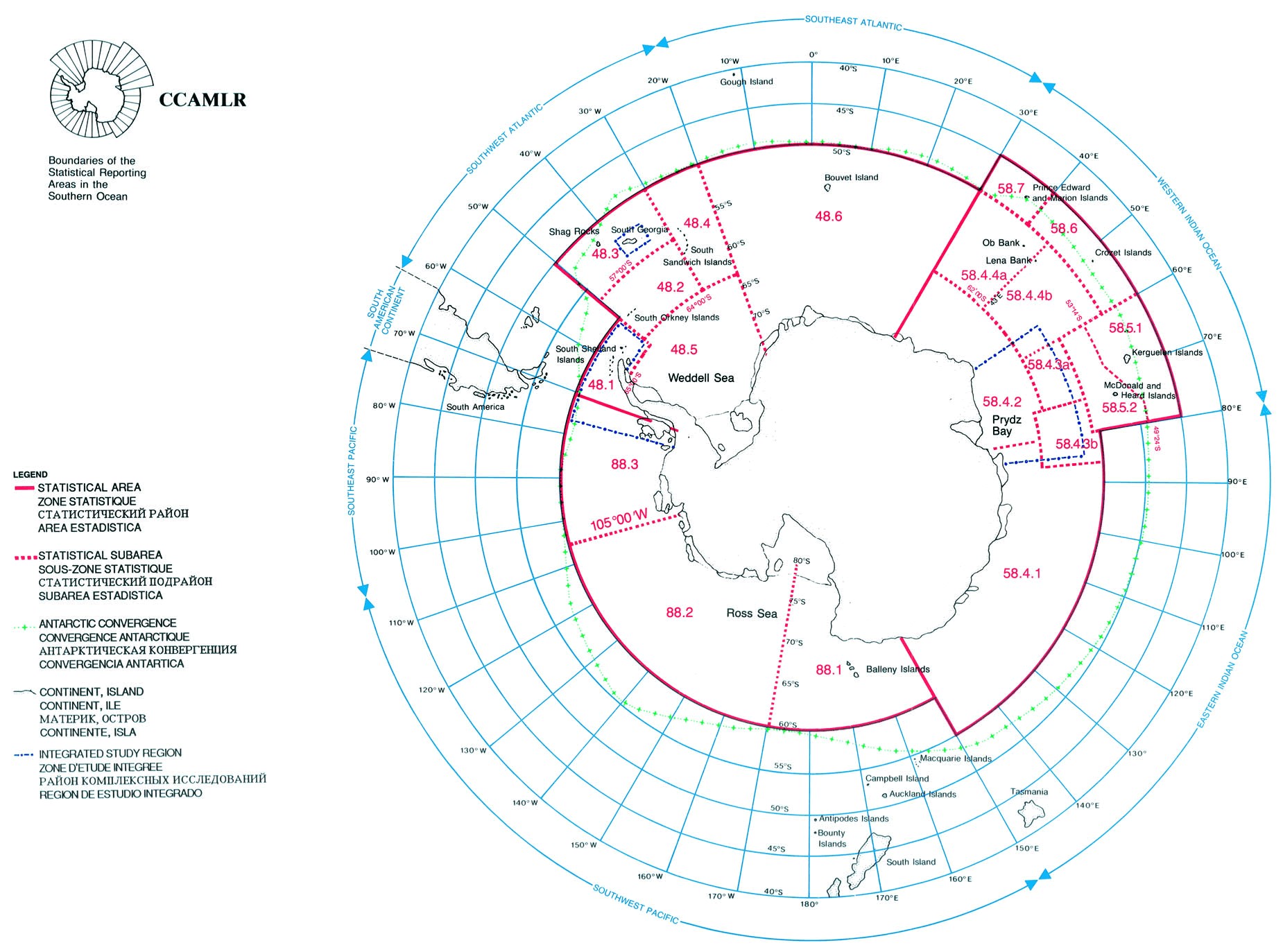Exhibition on the Theme
‘Beyond 60°S’ Exhibition
30 August – 30 November 2018
![]()

A Map showing the Convention Area described in CCAMLR (Source:www.ccamlr.org)
The Convention on the Conservation of Antarctic Marine Living Resources (‘CCAMLR’), an international convention designed to conserve Antarctic marine living resources, entered into force in 1982. The Commission for the Conservation of Antarctic Marine Living Resources (‘Commission’) was established under this convention to give effect to its objectives and principles, including regulating activities associated with the rational utilization and management of marine living resources in the Convention Area.
The Commission has adopted a suite of Conservation Measures to support the conservation of Antarctic marine living resources and the management of fisheries in the Southern Ocean. These Conservation Measures (CMs) set out the requirements related to gear specifications, data reporting, research activities and the establishment of marine protected areas.
Surrounding the continent of Antarctica, the Southern Ocean accounts for approximately 15% of the world’s ocean coverage and provides diverse habitats that support different forms of life. Although its biodiversity differs from that of other continents due to its extreme cold and dry environment, Antarctica and the Southern Ocean are home to many marine species, some of which are endemic to the continent.
Although Antarctica’s remoteness provides some protection, its biodiversity is threatened by pollution, introduced species, climate change and resources exploitation. Whales, seals and other marine creatures were first hunted in and around Antarctica in the 1790s. The emergence of large-scale fishing for finfish since the 1960s has further intensified the threat to the Southern Ocean’s marine biodiversity.
Toothfish
The preservation of the Antarctic and Patagonian toothfish (Dissostichus mawsoni and D. eleginoides), both of which are commonly found in the waters around Antarctica, is a major concern of the CCAMLR. The biological characteristics of toothfish (notably their longevity, large size, slow growth and late maturation) make them highly vulnerable to overfishing. These fishes are harvested and traded internationally. To better protect toothfish from illegal, unreported and unregulated (IUU) fishing, the Commission has introduced Conservation Measures (CMs) covering catch quotas, limits on mesh size and onboard observers for toothfish fisheries. The Commission has also adopted a CM on a Catch Documentation Scheme (CDS) to monitor the origins of the toothfish caught and the associated trading activities.
Other species
Other harvested species protected under CCAMLR include icefish and krill, which are covered by CMs specifying catch quota and requiring the presence of onboard observers. The mackerel icefish (Champsocephalus gunnari) is a benthic fish species native to the Southern Ocean. The species was heavily exploited as a seafood delicacy in the 1970s and 1980s, resulting in the closure of the fisheries in the early 1990s amid calls for sustainable fisheries management. Mackerel icefish may now only be harvested by licensed fisheries in specified areas, and only if surveys (conducted every two years) determine that sufficient stock is available..
The Antarctic krill (Euphausia superba) is the dominant species of Euphausiacea, an order of small crustaceans, and these krill are found only in the Southern Ocean. They constitute the main diet of many marine predators in the Antarctic ecosystem. Antarctic krill used to be one of the most abundant animal species on the planet, but the numbers of Antarctic krill have fluctuated in recent years due to environmental changes. The Commission aims to manage krill fishing in a precautionary manner, in order to minimize the threat to this ecosystem.
Other species such as penguins and seals are also protected under CCAMLR through the establishment of marine protected areas and the introduction of habitat management measures. Seabirds are protected from resources harvesting by gear restrictions. An ecosystem monitoring program has also been established for the several indicator species in the Antarctic ecosystem, which will obtain the necessary information to enable a sustainable harvesting and resource management strategy to be developed.
China acceded to CCAMLR in 2006, but the convention was not applied in Hong Kong as the volume of toothfish traded in Hong Kong was relatively small at that time. Although Hong Kong has no fishing vessels operating in the Convention Area, concern has arisen in recent years about the increasing volume of toothfish trade in Hong Kong.
In view of the increasing volume of the toothfish trade in Hong Kong, the Central People’s Government has agreed in principle to extend the application of CCAMLR to Hong Kong after consultation with the HKSAR Government, to protect the species from overfishing and to contribute more generally to the international effort to ensure the sustainable use of marine resources.
Domestic legislation will be enacted to provide the necessary legal basis for the implementation of CCAMLR and its CMs. After consultation with stakeholders, the HKSAR Government introduced the CAMLR Bill into the Legislative Council in July 2018. Once the bill is passed, two sets of regulations will be made. One will implement the Toothfish Catch Documentation Scheme locally, in order to regulate the trading of toothfish in Hong Kong, while the other will provide for port inspection and control of relevant vessels entering Hong Kong waters.
The implementation of the CCAMLR locally will align Hong Kong with the international effort to protect marine resources and promote their sustainable use.
For further interests, more information is available from The Antarctic of our sustainability hub.
A well-curated resources hub packed with information on environmental protection, climate change and sustainable development, and designed to inspire the public to take action to combat climate change.
